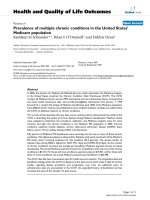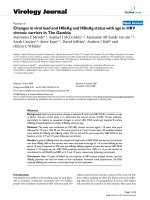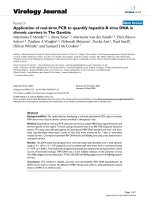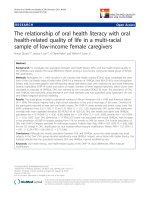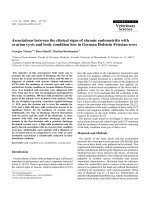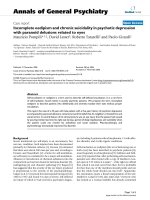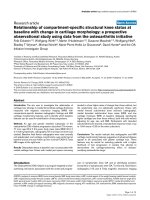Relationship of chronic endometritis with chronic deciduitis in cases of miscarriage
Bạn đang xem bản rút gọn của tài liệu. Xem và tải ngay bản đầy đủ của tài liệu tại đây (794.98 KB, 6 trang )
Kaku et al. BMC Women's Health
(2020) 20:114
/>
RESEARCH ARTICLE
Open Access
Relationship of chronic endometritis with
chronic deciduitis in cases of miscarriage
Shoji Kaku1, Takuro Kubo1, Fuminori Kimura1* , Akiko Nakamura1, Jun Kitazawa1, Aina Morimune1,
Akimasa Takahashi1, Akie Takebayashi1,2, Akiko Takashima1, Ryoji Kushima3 and Takashi Murakami1
Abstract
Background: The presence of chronic deciduitis (CD) was determined in patients diagnosed with or without
chronic endometritis (CE) before pregnancy.
Objective: To study the effect of CE on decidua in cases of miscarriage.
Methods: Decidual tissue was obtained from the patients who miscarried at the first pregnancy within a year after
the diagnosis of the presence or absence of CE. The number and distribution pattern of plasma cells stained with
CD138 in decidual tissue in 10 high-power fields (HPFs) was examined. The prevalence of CD diagnosed with four
different grade; grade 0, no plasma cell in 10 HPFs, thus Non-CD;grade 1, rare single plasma cells; grade 2, rare
clusters or more than 5 single cells total; and grade 3, many plasma cells with more than 5 clusters, were examined
and compared between Non-CE and CE.
Results: The incidence rate of CD of grade2 + 3 was significantly higher in CE than Non-CE (53.8%; 7/13 vs. 0%; 0/
13, P < 0.01). Presence of clusters or a number of plasma cells in 10 HPFs of decidua showed a sensitivity of 53.8%, a
specificity of 100%, a positive predictive value of 100%, and a negative predictive value of 68.4% for the diagnosis
of CE.
Conclusion: Presence of clusters of plasma cells or five or more of plasma cells in decidua was found in more than
half of CE, but not found in Non-CE. When CD with cluster or five or more of plasma cells is confirmed
histologically in miscarriage decidual tissue, the presence of CE before the pregnancy should be suspected.
Keywords: Chronic endometritis, Chronic deciduitis, Miscarriage
Background
Chronic endometritis (CE) is a slight inflammation of
the endometrium that is histologically diagnosed by the
presence of plasma cells in the stroma of the endometrium [1–5]. Several recent reports have shown that CE is
associated with infertility, implantation failure, and habitual abortion [6–11]. In addition, it has been reported
that the ongoing pregnancy rate is restored when CE is
cured with antibiotic treatment, suggesting that the
* Correspondence:
1
Department of Obstetrics and Gynecology, Shiga University of Medical
Science, Seta Tsukinowa-cho, Otsu, Shiga 520-2192, Japan
Full list of author information is available at the end of the article
cause of CE is microbial infection [9, 12–15]. The features of the endometrium in CE patients include an increase in the cytotoxic NK cell ratio [16], dysfunction of
decidualization [17], and an abnormal pattern of endometrial peristalsis [18], leading to infertility and implantation disorder. These physiological features before
pregnancy may continue even after pregnancy and may
be present in the decidua. However, so far, there has
been no reports of how the endometrium of CE patients
changes during pregnancy. The present study focused
on chronic deciduitis (CD) for the purpose of histologically examining the effects of CE on the decidua. CD is
defined as a type of long-term and slight inflammation
© The Author(s). 2020 Open Access This article is licensed under a Creative Commons Attribution 4.0 International License,
which permits use, sharing, adaptation, distribution and reproduction in any medium or format, as long as you give
appropriate credit to the original author(s) and the source, provide a link to the Creative Commons licence, and indicate if
changes were made. The images or other third party material in this article are included in the article's Creative Commons
licence, unless indicated otherwise in a credit line to the material. If material is not included in the article's Creative Commons
licence and your intended use is not permitted by statutory regulation or exceeds the permitted use, you will need to obtain
permission directly from the copyright holder. To view a copy of this licence, visit />The Creative Commons Public Domain Dedication waiver ( applies to the
data made available in this article, unless otherwise stated in a credit line to the data.
Kaku et al. BMC Women's Health
(2020) 20:114
of the decidua found during pregnancy [19–23]. Chronic
microbial infection and immune mechanisms have
been implicated as the etiology of CD [19, 24, 25].
The diagnosis of CD is similar to that of CE, depending histologically on the presence of plasma cells in
the decidua [19, 20].
In the present study, the effect of CE on the decidua
was determined by examining for the presence of plasma
cells and the incidence of CD, using the decidual tissue
of patients who became pregnant but miscarried following diagnosis with or without CE.
Methods
This research was approved by the Ethics Committee of
Shiga Medical University. Informed consent was obtained from the patients. The period of ovulation was
identified by a urine ovulation test and vaginal ultrasonography, and endometrial tissue around the center of
the anterior endometrium was collected with 4.5
J.A.M.W Type Uterine Curettes 5–9 days after ovulation
from September 2013 to May 2018. Immunostaining
with CD138 for endometrial tissue was performed according to previous reports [17, 26]. One of the gynecologists familiar with pathology judged the presence or
absence of CD138-positive plasma cells and diagnosed
CE when one or more CD138-positive plasma cells were
found in 10 HPFs (HPF = field magnified 400 times with
a microscope). Non-CE (control group) was defined
when plasma cells were not found in 10 visual fields. Patient information was obtained from the medical charts.
Patients who then underwent dilatation and curettage
due to miscarriage of the first pregnancy within a year
after the diagnosis of the presence or absence of CE
were included in the present study. Patients who became
pregnant after antibiotic treatment following the diagnosis of CE were excluded. The specimens of miscarriage
tissue were immunostained with CD138 in the same
manner as endometrial tissue, and the number of plasma
cells in 10 HPFs of decidual tissue was counted. When
one or more plasma cells were recognized in decidua,
CD was diagnosed. CD was divided into four grades according to the distribution pattern and number of
plasma cells in 10 HPFs: Grade 0, no plasma cell in 10
HPFs, thus Non-CD; Grade 1, 1 to 5 plasma cells in 10
HPFs; Grade 2, rare clusters or 5 to 20 plasma cells in
10 HPFs; and Grade 3, 20 or more plasma cells with
more than 5 clusters in 10 HPFs. The number of plasma
cells in 10 HPFs of decidual tissue and the prevalence of
CD in patients with or without CE were examined. In
addition, the percentage with CE was examined in NonCD and in CD cases.
We calculated the number of patients required for enrollment using software provided by the Department of
Biostatistics, Vanderbilt University (.
Page 2 of 6
vanderbilt.edu/wiki/Main/PowerSampleSize). Independent, case-control, two proportion, and Fisher’s exact test
were selected to measure the sample size in the section
of Dichotomous. We selected 0.05 for α (the probability
that we will falsely reject the null hypothesis), 0.8 for
power (β) (the probability of always rejecting the null hypothesis if the null hypothesis is false in the statistical
hypothesis test), 0 for P0 (the probability of the outcome
for a control patient in prospective studies), and 0.538
for P1 (the probability of the outcome in an experimental subject in prospective studies). When we chose 1 for
m (the ratio of control to experimental subjects for independent prospective studies), the calculation resulted in
sample sizes of 12 cases for the control group and 12
cases for the affected group. The numbers of the present
study were thus adequate.
Statistical analysis was performed using Graph Pad
Prism 5 (GraphPad Software Inc., La Jolla, CA). Each
dataset was analyzed for a normal distribution using the
Kolmogorov-Smirnov test, and Student’s t-test or the
non-parametric Mann-Whitney U test was used depending on the distribution pattern. The significance of differences in the pregnancy rate, live birth rate, and
miscarriage rate between the Non-CE group and the CE
group was examined using Fisher’s analysis. A significant
difference was considered present when the P value was
less than 0.05.
Results
Thirteen patients diagnosed with Non-CE became pregnant, but miscarried (Control; Non-CE group), and 13
patients who were diagnosed with CE and subsequently
became pregnant, but miscarried (CE group) were enrolled. There were no differences in age, gravidity, parity,
and gestational weeks at the time of dilatation and curettage between the Non-CE and CE groups (Table 1). The
numbers of plasma cells (mean ± standard error of the
mean) in 10 HPFs of decidual tissue were 0.54 ± 0.24
and 14.0 ± 5.88 (P < 0.01) in the Non-CE and CE groups,
respectively (Fig. 1a, b, c, d, Fig. 2). Grade 1 CD was
found in the Non-CE group, and Grade 1, 2, and 3 CD
were found in the CE group (Table 1). The ratios of
Grade 1 CD were 30.8% (4/13) and 15.4% (2/13) (P =
0.64) in the Non-CE group and CE group, respectively
(Table 1). Similarly, the ratios of Grade 2 CD were 0%
(0/13) and 30.8% (4/13) (P = 0.48), respectively, and the
proportions of Grade 3 CD were 0% (0/13) and 23.1%
(0/13) (P = 0.22), respectively (Table 1). The ratios of CD
when defined as Grade 1 + Grade 2 + Grade 3 CD were
30.8% (4/13) and 69.2% (9/13) (P = 0.12), and the rates
of Grade 2 + Grade 3 CD were 0% (0/13) and 53.8% (7/
13) (P < 0.01) in the Non-CE group and CE group, respectively (Table 1). Of these, only the rates of Grade
Kaku et al. BMC Women's Health
(2020) 20:114
Page 3 of 6
Table 1 Patients’ characteristics and the prevalence of CD by grade in the Non-CE and CE groups
Age, y, mean ± SEM
Non-CE
CE
N = 13
N = 13
37.31 ± 1.11
37.31 ± 1.12
P
value
.99
Gravidity, mean ± SEM
2.15 ± 0.32
1.46 ± 0.14
.15
Parity, mean ± SEM
0.38 ± 0.14
0.23 ± 0.12
.67
Gestational weeks at the time of miscarriage, mean ± SEM
8w6.25d ± 1.74d
9w0.46d ± 0.84d
.53
CD
Grade 0 (%)
Grade 1 (%)
9 (69.2)
4 (30.8)
4 (30.8)
2 (15.4)
.12
.64
Grade 2 (%)
0 (0)
4 (30.8)
.48
Grade 3 (%)
0 (0)
3 (23.1)
.22
Cause of infertility
Grade 1 + 2 + 3 (%)
4 (30.8)
9 (69.2)
.12
Grade 2 + 3 (%)
0 (0)
7 (53.8)
<.01
Male factor
3
3
Tubal factor
3
3
Endometriosis
2
2
Ovarian factor
3
0
Antisperm antibody
0
0
Fertilization failure
0
0
Unknown
2
5
CD Chronic deciduitis, CE Chronic Endometritis, SEM Standard error of mean
2 + Grade 3 CD were significantly different between the
two groups.
The prevalence of CE before pregnancy was examined
according to the presence or absence of CD. When CD
was defined as the total of Grade 1 + Grade 2 + Grade 3,
the ratios of CE before pregnancy were 30.8% (4/13) and
69.2% (9/13) (P = 0.12) in the Non-CD group and CD
group. Similarly, when it was defined as Grade 2 + Grade
3, the ratios were 31.6% (6/19) and 100% (7/7 3) (P <
0.01), respectively. The ratios were 43.5% (10/23) and
100% (3/3) (P = 0.22), respectively, when it was only
Grade 3.
With respect to the diagnosis of CE, Grade 2 + Grade
3 CD showed a sensitivity of 53.8%, a specificity of 100%,
Fig. 1 Immunohistochemistry of CD138 for decidual tissue. a No cells stained with CD138 are found in Non-CD. b. Grade 1 CD, one to 5 plasma
cells found in 10 HPFs. c. Grade 2 CD, rare clusters or 5 to 20 plasma cells in 10 HPFs. d. Grade 3 CD, 20 or more plasma cells with more than 5
clusters in 10 HPFs. Bar = 100 μm
Kaku et al. BMC Women's Health
(2020) 20:114
Fig. 2 The number of plasma cells in the decidual tissue in Non-CE
and CE patients. The numbers of plasma cells (mean ± standard
error) in 10 HPFs of decidual tissue is 0.52 ± 0.17 and 14.0 ± 5.88 (P <
0.01) in Non-CE and CE patients, respectively.
a positive predictive value of 100%, and a negative predictive value of 68.4%.
Discussion
According to the results of the present study, CD with
the presence of a cluster or a number of plasma cells
was frequently found when a CE patient became pregnant and miscarried. This suggested that inflammation
in the endometrium remains in the decidua of some
cases of miscarriage.
CD is pathologically diagnosed with the presence of
plasma cells within the decidua (decidual endometrium).
Although studies of CD in preterm and/or term pregnancy have been reported [20, 23], there have been no
reports of CD in early-stage pregnancy. Therefore, there
are no diagnostic criteria for CD in early pregnancy. Gilmore et al. pointed out that the histologic diagnostic criteria for CE differ from the literature and used a
semiquantitative scoring system to avoid these problems
[27]. They divided the status into 4 grades: grade 0, no
plasma cells seen; grade 1, rare single plasma cells; grade
2, rare clusters or more than 5 single cells total; and
grade 3, many plasma cells with more than 5 clusters. In
the present study, CD for the specimens of miscarriage
cases was classified based on the report by Gilmore et al.
That is, Non CD was defined as no plasma cells seen,
and CD was divided into 3 grades: grade 1, 1 to 5 plasma
cells in 10 HPFs; grade 2, rare clusters or 5 to 20 plasma
cells in 10 HPFs; and grade 3, 20 or more plasma cells
with more than 5 clusters in 10 HPFs. It was found that
there were no significant differences in the incidence of
CD of Grade 1, Grade 2, Grade 3, or Grade 1 + Grade
2 + Grade 3 between the Non-CE and CE groups. However, there was a significant difference in the incidence
of Grade 2 + Grade 3 CD. In addition, although the
number of cases was small in this study, Grade 2 or
Page 4 of 6
Grade 3 CD was not seen at all in Non-CE patients. In
general, the number of immune cells per area is considered to be correlated with the degree of histological inflammation. Thus, our results suggested CD with
moderate or higher inflammation was observed only in
CE patients.
The association between CE and habitual abortion has
been reported [8, 10]. Considering these clinical data
and the fact that there is a higher incidence of CD when
CE patients miscarry, CD appears to be related to
miscarriage.
Plasma cells, which are the basis of the diagnosis of
CD, produce the antibody for some kind of antigen. In
patients diagnosed with CD in the present study, maternal immunity may have reacted to the chorionic tissue
(placental tissue) as an antigen during the course of miscarriage. Grade 1 CD was found in 4/13 Non-CE patients who miscarried. Such a histologically mild degree
of CD may have been due to miscarriage.
In the total cases of Grade 2 and Grade 3 CD, the incidence of CE before the pregnancy was 100%. Thus,
when Grade 2 or Grade 3 CD is found in the miscarriage
tissue, it means that CE existed before pregnancy in all
cases, although the number of samples was low in the
present study. Specimens from miscarriage cases have
been used to confirm the presence of chorionic tissue
and the exclusion of chorionic diseases such as molar
pregnancy. If specimens obtained from a patient who
miscarried are examined for the presence of CD, this
may provide a clue regarding the presence of CE before
the pregnancy, which may be useful for the subsequent
fertility treatment.
To the best of our knowledge, this is the first study in
the world to study the relationship between CE and CD
in miscarriage specimens in order to investigate the direct effects of CE on pregnancy. Currently, when diagnosed as CE, the patient is usually treated with
antibiotics and then undergoes embryo transfer. When
the present study was conducted, it was already beginning to be thought that antibiotics might be effective to
improve clinical outcomes. The patients in the CE group
extracted for the present study were those who did not
want antibiotic treatment. In this sense, the cases who
became pregnant but miscarried following their diagnosis with or without CE are few and extremely valuable.
Furthermore, the miscarriage specimens of these patients were even more valuable, and the results of the
analysis of the miscarriage specimens could be compared
with the presence or absence of CE. This is the strength
of the present study.
On the other hand, although the numbers of cases and
controls satisfied the power analysis, they were relatively
small. Patients who sought antibiotic treatment were
treated with them and excluded from the study. Though
Kaku et al. BMC Women's Health
(2020) 20:114
this attitude is ethically correct, this means that the CE
group did not reflect all CE patients in the study period.
These are the limitations of the present study.
In the future, it is important to investigate the effects
of antibiotic treatment for CE on the incidence of CD in
this area of research. In addition, conversely, it is very
important to study whether a patient diagnosed with CD
in a miscarriage will subsequently be diagnosed with CE.
We hope that this research provides new insights into
the relationships among CE, CD, and miscarriage.
Conclusions
Histopathological analysis of specimens from cases of
miscarriage showed clusters of plasma cells or five or
more plasma cells found in the decidua in more than
half of CE patients, whereas they were not found in
Non-CE patients. This suggests that the effect of CE remains in the decidua during pregnancy. In addition,
when the presence of a plasma cell cluster or five or
more of plasma cells in 10 HPFs is confirmed histologically, the presence of CE before the pregnancy should be
suspected. The analysis of the presence of CD in the
specimens of miscarriage may help subsequent fertility
treatment.
Abbreviations
CD: Chronic deciduitis; CE: Chronic endometritis; HPF: high-power fields; NK
cell: Natural killer cell
Acknowledgements
Nothing to disclose.
Capsule
The effect of chronic endometritis remains in the decidua of more than half
of miscarriage cases, which are considered to be chronic deciduitis with a
cluster or a number of plasma cells.
Authors’ contributions
Conception and design: FK; contributed reagents/materials/analysis tools: SK,
FK, AN, JK, AM, AT, AT, AT; performing the experiment: SK, TK, RK; analyzed
the data: SK, FK; drafting the manuscript: FK. final approval of the version: RK,
TM. All authors read and approved the final manuscript.
Funding
The Grants-in-Aid for Scientific Research of Japan Society for the Promotion
of Science, Grant Number 16 K11083 and 19 K09752. (to F.K.).
Availability of data and materials
We can provide the raw data. The datasets used and/or analyzed during the
current study available from the corresponding author on reasonable
request.
Ethics approval and consent to participate
This research was approved by the Ethics Committee of Shiga University of
Medical Science (IRB-ethics committee approval number, R2014–090).
Consent for publication
Informed written consent was obtained for publication.
Competing interests
No author has any conflict of interest to disclose.
Page 5 of 6
Author details
1
Department of Obstetrics and Gynecology, Shiga University of Medical
Science, Seta Tsukinowa-cho, Otsu, Shiga 520-2192, Japan. 2Department of
Obstetrics and Gynecology, National Hospital Organization Shiga Hospital,
255 Gochi-cho, Higashioumi, Shiga 527-8505, Japan. 3Department of Clinical
Laboratory Medicine and Division of Diagnostic Pathology, Shiga University
of Medical Science, Seta Tsukinowa-cho, Otsu, Shiga 520-2192, Japan.
Received: 17 January 2020 Accepted: 26 May 2020
References
1. Greenwood SM, Moran JJ. Chronic endometritis: morphologic and clinical
observations. Obstet Gynecol. 1981;58:176–84.
2. Bayer-Garner IB, Korourian S. Plasma cells in chronic endometritis are easily
identified when stained with syndecan-1. Mod Pathol. 2001;14:877–89.
3. Smith M, Hagerty KA, Skipper B, Bocklage T. Chronic endometritis: a
combined histopathologic and clinical review of cases from 2002 to 2007.
Int J Gynecol Pathol. 2010;29:44–50.
4. Kitaya K, Yasuo T. Immunohistochemistrical and clinicopathological
characterization of chronic endometritis. Am J Reprod Immunol. 2011;66:
410–5.
5. Kimura F, Takebayashi A, Ishida M, Nakamura A, Kitazawa J, Morimune A,
et al. Review: chronic endometritis and its effect on reproduction. J Obstet
Gynaecol Res. 2019;45:951–60.
6. Kasius JC, Fatemi HM, Bourgain C, Sie-Go DM, Eijkemans RJ, Fauser BC, et al.
The impact of chronic endometritis on reproductive outcome. Fertil Steril.
2011;96:1451–6.
7. Johnston-MacAnanny EB, Hartnett J, Engmann LL, Nulsen JC, Sanders MM,
Benadiva CA. Chronic endometritis is a frequent finding in women with
recurrent implantation failure after in vitro fertilization. Fertil Steril. 2010;93:
437–41.
8. McQueen DB, Bernardi LA, Stephenson MD. Chronic endometritis in women
with recurrent early pregnancy loss and/or fetal demise. Fertil Steril. 2014;
101:1026–30.
9. Cicinelli E, Matteo M, Tinelli R, Lepera A, Alfonso R, Indraccolo U, et al.
Prevalence of chronic endometritis in repeated unexplained implantation
failure and the IVF success rate after antibiotic therapy. Hum Reprod. 2015;
30:323–30.
10. Bouet PE, El Hachem H, Monceau E, Gariépy G, Kadoch IJ, Sylvestre C.
Chronic endometritis in women with recurrent pregnancy loss and
recurrent implantation failure: prevalence and role of office hysteroscopy
and immunohistochemistry in diagnosis. Fertil Steril. 2016;105:106–10.
11. McQueen DB, Perfetto CO, Hazard FK, Lathi RB. Pregnancy outcomes in
women with chronic endometritis and recurrent pregnancy loss. Fertil Steril.
2015;104:927–31.
12. Yang R, Du X, Wang Y, Song X, Yang Y, Qiao J. The hysteroscopy and
histological diagnosis and treatment value of chronic endometritis in recurrent
implantation failure patients. Arch Gynecol Obstet. 2014;289:1363–9.
13. Kitaya K, Matsubayashi H, Takaya Y, Nishiyama R, Yamaguchi K, Takeuchi T,
et al. Live birth rate following oral antibiotic treatment for chronic
endometritis in infertile women with repeated implantation failure. Am J
Reprod Immunol. 2017;78:e12719.
14. Cicinelli E, Matteo M, Trojano G, Mitola PC, Tinelli R, Vitagliano A, et al.
Chronic endometritis in patients with unexplained infertility: Prevalence and
effects of antibiotic treatment on spontaneous conception. Am J Reprod
Immunol. 2018;79:e12782.
15. Vitagliano A, Saccardi C, Noventa M, Di Spiezio SA, Saccone G, Cicinelli E,
et al. Effects of chronic endometritis therapy on in vitro fertilization
outcome in women with repeated implantation failure: a systematic review
and meta-analysis. Fertil Steril. 2018;110:103–12.
16. Di Pietro C, Cicinelli E, Guglielmino MR, Ragusa M, Farina M, Palumbo MA,
et al. Altered transcriptional regulation of cytokines, growth factors, and
apoptotic proteins in the endometrium of infertile women with chronic
endometritis. Am J Reprod Immunol. 2013;69:509–17.
17. Wu D, Kimura F, Zheng L, Ishida M, Niwa Y, Hirata K, et al. Chronic
endometritis modifies decidualization in human endometrial stromal cells.
Reprod Biol Endocrinol. 2017;15:16.
18. Pinto V, Matteo M, Tinelli R, Mitola PC, De Ziegler D, Cicinelli E. Altered
uterine contractility in women with chronic endometritis. Fertil Steril. 2015;
103:1049–52.
Kaku et al. BMC Women's Health
(2020) 20:114
19. Riaz N, Wolden SL, Gelblum DY, Eric J. Chronic inflammation of the
placenta: definition, classification, pathogenesis, and clinical significance. Am
J Obstet Gynecol. 2016;118:6072–8.
20. Edmondson N, Bocking A, Machin G, Rizek R, Watson C, Keating S. The
prevalence of chronic Deciduitis in cases of preterm labor without clinical
Chorioamnionitis. Pediatr Dev Pathol. 2009;12:16–21.
21. Khong YEE, Robert W, Qureshi F, Raymond W, Gould S, Stallmach T, et al.
Chronic Deciduitis in the placental basal plate : definition and Interobserver
reliability first round of assessment. Hum Pathol. 2000;31:292–5.
22. Bendon RW, Miller M. Routine pathological examination of placentae from
abnormal pregnancies. Placenta. 1990;11:369–70.
23. Salafia CM, Vogel CA, Vintzileos AM, Bantham KF, Pezzullo J, Silberman L.
Placental pathologic findings in preterm birth. Am J Obstet Gynecol. 1991;
165:934–8.
24. Perni SC, Predanic M, Cho JE, Baergen RN. Placental pathology and
pregnancy outcomes in donor and non-donor oocyte in vitro fertilization
pregnancies. J Perinat Med. 2005;33:27–32.
25. Gundogan F, Bianchi DW, Scherjon SA, Roberts DJ. Placental pathology in
egg donor pregnancies. Fertil Steril. 2010;93:397–404.
26. Takebayashi A, Kimura F, Kishi Y, Ishida M, Takahashi A, Yamanaka A, et al.
The association between endometriosis and chronic endometritis. PLoS
One. 2014;9:e88354.
27. Gilmore H, Fleischhacker D, Hecht JL. Diagnosis of chronic endometritis in
biopsies with stromal breakdown. Hum Pathol. 2007;38:581–4.
Publisher’s Note
Springer Nature remains neutral with regard to jurisdictional claims in
published maps and institutional affiliations.
Page 6 of 6

